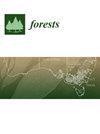Using a Logistic Regression Model to Examine the Variables Influencing Changes in Northern Thailand’s Forest Cover and Comparing Machine Learning Algorithms
IF 2.4
2区 农林科学
Q1 FORESTRY
引用次数: 0
Abstract
Protecting biodiversity and keeping the Earth’s temperature stable are both very important jobs performed by tropical forests. In the last few decades, remote sensing has given us new tools and ways to track changes in land cover. To understand what causes changes in forest cover, it is important to look at the things that affect those changes. However, there is not enough research that uses a logistic regression model (LRM) and compares the results with machine learning (ML) techniques to investigate the specific factors that cause forest cover change in remote mountainous areas like Thailand’s Mae Hong Son and Chiang Mai Provinces. Following a comparison of an LRM, a random forest, and an SVM, this study of the causes of changes in forest cover in Mae Hong Son found six important factors: soil series, rock types, slope, the NDVI, the NDWI, and the distances to city areas. Compared to the LRM, both the RF and SVM machine learning algorithms had higher values for the kappa coefficient, sensitivity, specificity, accuracy, positive and negative predictions, and sensitivity, especially the RF. Following what was found in Mae Hong Son, when the important factors were examined in Chiang Mai, the RF came out on top. It is believed that these results can be used in more situations to help make plans for restoring ecosystems and to promote long-lasting methods of managing land use.使用逻辑回归模型研究影响泰国北部森林覆盖率变化的变量并比较机器学习算法
保护生物多样性和保持地球温度稳定都是热带森林的重要职责。在过去的几十年里,遥感技术为我们提供了跟踪土地覆盖变化的新工具和新方法。要了解森林植被变化的原因,就必须研究影响这些变化的因素。然而,使用逻辑回归模型(LRM)并将结果与机器学习(ML)技术进行比较,以研究导致泰国夜丰颂府和清迈府等偏远山区森林植被变化的具体因素的研究还不够多。在对 LRM、随机森林和 SVM 进行比较后,这项关于夜丰颂森林覆盖率变化原因的研究发现了六个重要因素:土壤系列、岩石类型、坡度、NDVI、NDWI 和与城市地区的距离。与 LRM 相比,RF 和 SVM 机器学习算法的卡帕系数、灵敏度、特异性、准确性、正负预测和灵敏度值都更高,尤其是 RF。与在夜丰颂发现的情况一样,在清迈对重要因素进行研究时,RF 算法也名列前茅。相信这些结果可用于更多情况,以帮助制定恢复生态系统的计划,并推广长期管理土地使用的方法。
本文章由计算机程序翻译,如有差异,请以英文原文为准。
求助全文
约1分钟内获得全文
求助全文
来源期刊

Forests
FORESTRY-
CiteScore
4.40
自引率
17.20%
发文量
1823
审稿时长
19.02 days
期刊介绍:
Forests (ISSN 1999-4907) is an international and cross-disciplinary scholarly journal of forestry and forest ecology. It publishes research papers, short communications and review papers. There is no restriction on the length of the papers. Our aim is to encourage scientists to publish their experimental and theoretical research in as much detail as possible. Full experimental and/or methodical details must be provided for research articles.
 求助内容:
求助内容: 应助结果提醒方式:
应助结果提醒方式:


